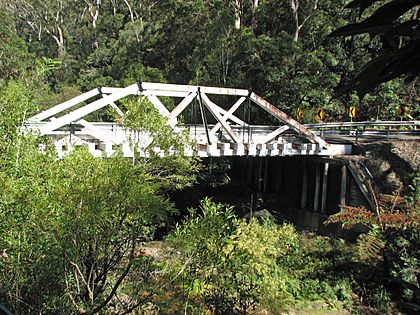Tunks Creek Bridge facts for kids
Quick facts for kids Tunks Creek Bridge |
|
|---|---|

Tunks Creek bridge, 2018
|
|
| Coordinates | 33°39′57″S 151°04′45″E / 33.6657°S 151.0793°E |
| Carries | Galston Road (Main Road 161) |
| Crosses | Tunks Creek |
| Locale | Galston, Berowra Valley Regional Park, Hornsby Shire, New South Wales, Australia |
| Official name | Tunks Creek bridge, Galston |
| Other name(s) |
|
| Owner | Roads and Maritime Services |
| Characteristics | |
| Design | McDonald truss bridge |
| Material | Timber |
| Total length | 20 metres (65 ft) |
| Width | 5 metres (15 ft) |
| Longest span | 20 metres (65 ft) |
| Number of spans | One |
| History | |
| Constructed by | NSW Department of Public Works |
| Construction begin | 1893 |
| Construction cost | A£265 |
| Opened | 1894 |
| Official name: Bridge over Tunks (Pearces) Creek; Pearces Creek Bridge | |
| Type: | State heritage (built) |
| Designated: | 20 June 2000 |
| Reference #: | 1478 |
| Type: | Road Bridge |
| Category: | Transport - Land |
| Builders: | NSW Department of Public Works |
The Tunks Creek bridge is a special timber bridge in New South Wales, Australia. It is listed on the heritage register, meaning it's an important historical structure. This bridge carries Galston Road over Tunks Creek. You can find it in Galston, which is part of the Berowra Valley Regional Park in the Hornsby Shire area of Sydney.
The bridge helps connect Hornsby Heights and Galston. It's also known by other names like the Bridge over Tunks (Pearces) Creek and Pearces Creek Bridge. The bridge is looked after by Roads and Maritime Services, which is a part of the NSW government. It was added to the New South Wales State Heritage Register on June 20, 2000.
Contents
Why Was the Tunks Creek Bridge Built?
Timber bridges were very common in New South Wales a long time ago. This was because there was plenty of strong local wood, but not much steel. Engineers in New South Wales became very good at building timber bridges. The McDonald truss design, used for this bridge, was an important step in how these timber bridges developed. This type of bridge came in three standard lengths: 65 feet (20 m), 75 feet (23 m), and 90 feet (27 m).
The bridge at Tunks Creek was built to make it easier for fruit farmers in the Galston area to get their produce to market. Before this road, it was a much longer journey. The construction of the bridge also helped provide jobs during a tough economic time in the early 1890s. Work on the bridge started in February 1893 and it was finished by early 1894.
What Does the Tunks Creek Bridge Look Like?
The Galston Bridge is a single-span timber bridge. It uses a special design called a McDonald truss. It was built between 1893 and 1894 by the NSW Department of Public Works. The bridge crosses Tunks Creek in Galston Gorge, which is east of Hornsby.
At 65 feet (20 m) long, it's the shortest of the remaining timber truss bridges in New South Wales. The bridge rests on timber supports at each end. It is 15 feet (4.6 m) wide between the edges. The road leading to the bridge has sharp turns at both ends. This bridge will stay as it is, without being updated with modern materials. This is because the winding Galston Road has a limit on how heavy vehicles can be, so the bridge doesn't need to carry very heavy loads.
The bridge has only one lane for traffic. There are "give-way" signs at both ends. This means that cars already on the bridge have the right to go first. The bridge cost about A£265 to build back then.
How Has the Bridge Changed Over Time?
The Tunks Creek Bridge has had some repairs and updates since it was built:
- In 1958, a central support beam was replaced.
- Between 1961 and 1963, some cross beams and other parts of the truss were replaced. Two timber piles and a timber support were added near the Hornsby side.
- In 1978, more beams, the bridge deck, and steel plates were replaced.
- Around 1980, some support struts and deck planks were replaced.
What Condition Is the Bridge In?
In July 2002, after some big repairs between November 2001 and February 2002, the bridge was in good condition. By April 2009, its condition was still considered good.
Why Is the Tunks Creek Bridge Important?
The Tunks Creek bridge was added to the New South Wales State Heritage Register on June 20, 2000. This means it's recognized as a very important part of the state's history and culture.
As of April 2019, only five of the 91 McDonald truss bridges built in New South Wales are still standing, and the Galston Bridge is one of them.
Timber truss road bridges were very important for building and improving the road network in New South Wales. Before these bridges, crossing rivers was often dangerous, especially when it rained. This made it very expensive to move goods like farm produce.
The government preferred timber truss bridges from the mid-1800s to the early 1900s. They were cheaper to build and used mostly local materials. At that time, the government didn't have much money. They wanted to build as many roads and bridges as possible for the lowest cost, using materials found in New South Wales. This meant they couldn't use much iron and steel, which had to be brought in from England.
New South Wales was even known as the "timber bridge state" because these bridges were so common.
Gallery



